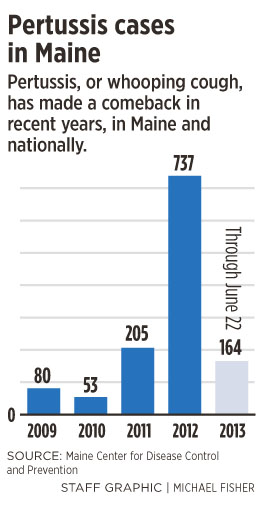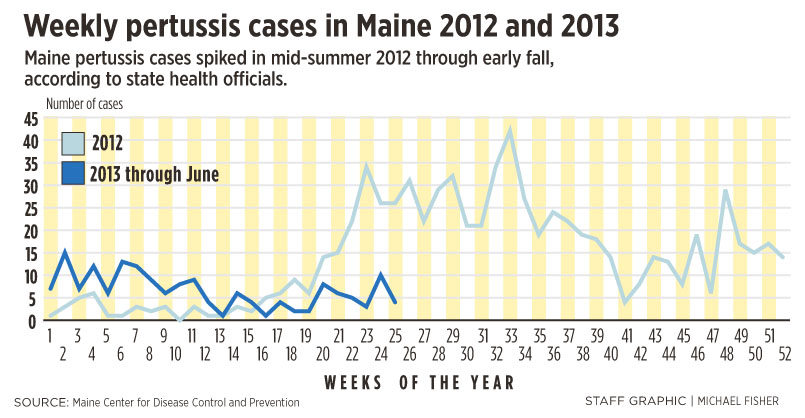The worst year since at least the 1960s for whooping cough cases in Maine started out slowly.
While the first half of 2012 saw just a handful of cases, according to statistics released by the Maine Center for Disease Control and Prevention, reports of pertussis began to pick up by May and mushroomed during the summer and early fall before falling back in mid-October.
Whether 2013 will have an outbreak as severe as last year’s is still in question, officials said. The 2013 numbers are so far tracking in a similar manner to 2012, but the bulk of last year’s surge happened in midsummer and early fall. Unlike influenza, which peaks in the winter, pertussis outbreaks can happen during any season, officials said.
Maine ended 2012 with 737 reported cases of pertussis, giving it the seventh-highest per capita rate in the nation, according to the U.S. Centers for Disease Control and Prevention. Most happened in the last six months of the year.
If the second half of 2012 had been similar to the first half, Maine would have finished with about 300 cases instead of 737.
“It’s unpredictable,” said Sheila Pinette, executive director of the Maine CDC. “We don’t know when or where it will happen.”
Nationally, whooping cough has surged back after decades of being almost eradicated from the infectious-disease landscape.
Before the whooping cough vaccine became available in the late 1940s, hundreds of thousands of cases were reported annually.
Pertussis cases plunged to a few thousand per year in the 1970s and 1980s, but the numbers are now rising, although not to 1940s levels. About 41,000 pertussis cases were reported nationally in 2012.
EXPLAINING THE OUTBREAK DIFFICULT
In Maine, the specifics of how the 2012 outbreak happened and why some counties were hit hard while others saw few cases are unknown, officials said.
For instance, Somerset County experienced 102 cases in 2012, the highest per-capita rate in the state. But only one case surfaced in neighboring Franklin County. In Cumberland County, 225 residents suffered from pertussis, the fourth-highest rate in the state, but neighboring York County had only 70 cases, where the per-capita rate was far below the state average.
“We know where it was,” said Dr. Stephen Sears, the state epidemiologist. “We don’t know why.”
Not only was the geographic distribution of pertussis uneven, but the timing of the outbreak varied from county to county, officials said.
For instance, Cumberland County’s outbreak peaked in August and September, with 86 cases in two months. Meanwhile, Somerset County’s pertussis cases skyrocketed in May and June, when 56 of its 102 cases occurred. But pertussis petered out in Somerset County by early August, according to state records.
Even why the outbreak happened at all is not clear, but Sears and Pinette have some theories. Maine’s population swells in the summer tourist season, which means different populations of people are intermingling at higher densities, Pinette said, making it more likely that infectious diseases will spread.
Whooping cough can last 90 days or longer, and can be lethal for infants. It’s most contagious a few days before symptoms appear and the first week after symptoms begin, officials said.
Sears said summer camps and the start of school also expose students to more dense and different populations. In Cumberland County, 49 cases occurred between Aug. 20 and Sept. 20. Sears said summer camps are probably not as much of a factor as school, because of the longer time periods that students spend indoors at school.
Mary Deschenes, executive director of the Maine Youth Camping Foundation, said camps, like schools, promote vaccines but do not require children to be immunized. But most camps do require records of vaccinations. “That way, we know who’s immunized and who isn’t,” Deschenes said. She said most camps will also call the families a few days before the start of camp to ask about any health problems with the child or family members.
BOOSTER SHOTS MISSED AT AGE 11
Another factor is the number of pre-teens who miss their booster shots at age 11 for pertussis, tetanus and diphtheria. Sears said the booster shot is not on the radar for many parents, and without the booster, the vaccine’s protection starts wearing off.
Of the 737 cases last year, 463 were in the 7-19 age group, according to the Maine CDC. Sixty-nine percent of Maine students ages 13-17 had received their age 11 booster shot, compared with 78 percent nationwide, according to the federal CDC. Maine had the lowest rate of 11-year-olds getting booster shots of any state in the Northeast.
Sears said he would be in favor of a state law that mandates age 11 booster shots as a requirement to attend school.
“That would be a helpful strategy,” he said.
Although vaccines are required in Maine, parents sending their children to school can opt out if they sign a statement citing religious or philosophical beliefs opposing vaccines. Most states have some sort of religious or philosophical exemption, but some states require more rigorous documentation, such as a notarized affidavit or a doctor’s note, according to the National Vaccine Information Center.
Maine is one of 17 states that allow a philosophical exemption not tied to religious beliefs, according to the vaccine center.
Sears said the anti-vaccination movement is probably not much of a factor in Maine, although it could be in other states where anti-vaccination sentiment is stronger.
“The percentage of people who don’t vaccinate their children in Maine is rather small,” Sears said. The anti-vaccination movement became more popular in the late 1990s and early 2000s, when some blamed vaccinations for causing autism. Research linking vaccinations to autism has been debunked, according to the Institute of Medicine.
Nevertheless, the pertussis vaccine itself is perhaps not as effective as it was before it was changed in the 1990s in an effort to reduce side effects, Sears said. Researchers with the federal CDC are examining potential solutions, including perhaps introducing a booster shot at age 8, Sears said. The current vaccination schedule includes six shots from childhood through age 11, including booster shots for adults every 10 years.
Sears said that aside from a state law that would require the booster shots for 11-year-olds to enter school, the state is emphasizing public education.
Although the state Department of Health and Human Services is not spending more money on marketing, it is doing more outreach on pertussis with the media, medical professionals and the public.
The message is getting out to the medical community to emphasize vaccines, not only for pertussis, but for other diseases, said Dr. Amy Barksdale of the Portland Community Health Center.
She said pertussis was not discussed much in medical school years ago, probably because it was so rare. And, at the outset, pertussis can be difficult for primary care physicians to diagnose, since in the first few days it can seem like a typical upper respiratory infection.
After a few days of coughing, the “whoop” sound starts to manifest itself, and coughing can be so violent that sufferers have trouble catching their breath, Barksdale said. Antibiotics are used to treat the disease.
To make sure vaccines are a priority, the clinic is now calling patients to remind them they need to come in for their vaccines. Vaccines for pertussis and other diseases are given when children come in for their sports physicals and when patients come in for other reasons, said Susan Huff, a medical assistant at the clinic who manages the vaccine program.
Sears said the state is also making sure that pregnant women are vaccinated for pertussis so that the mother does not pass on pertussis to her infant child. Infants are the most vulnerable to dying from pertussis.
“We’re so concerned about the small children,” Sears said. “It’s a very serious issue if the baby is less than 6 months old.”
Joe Lawlor can be contacted at 791-6376 or at:
jlawlor@pressherald.com
Twitter: @joelawlorph
Send questions/comments to the editors.






